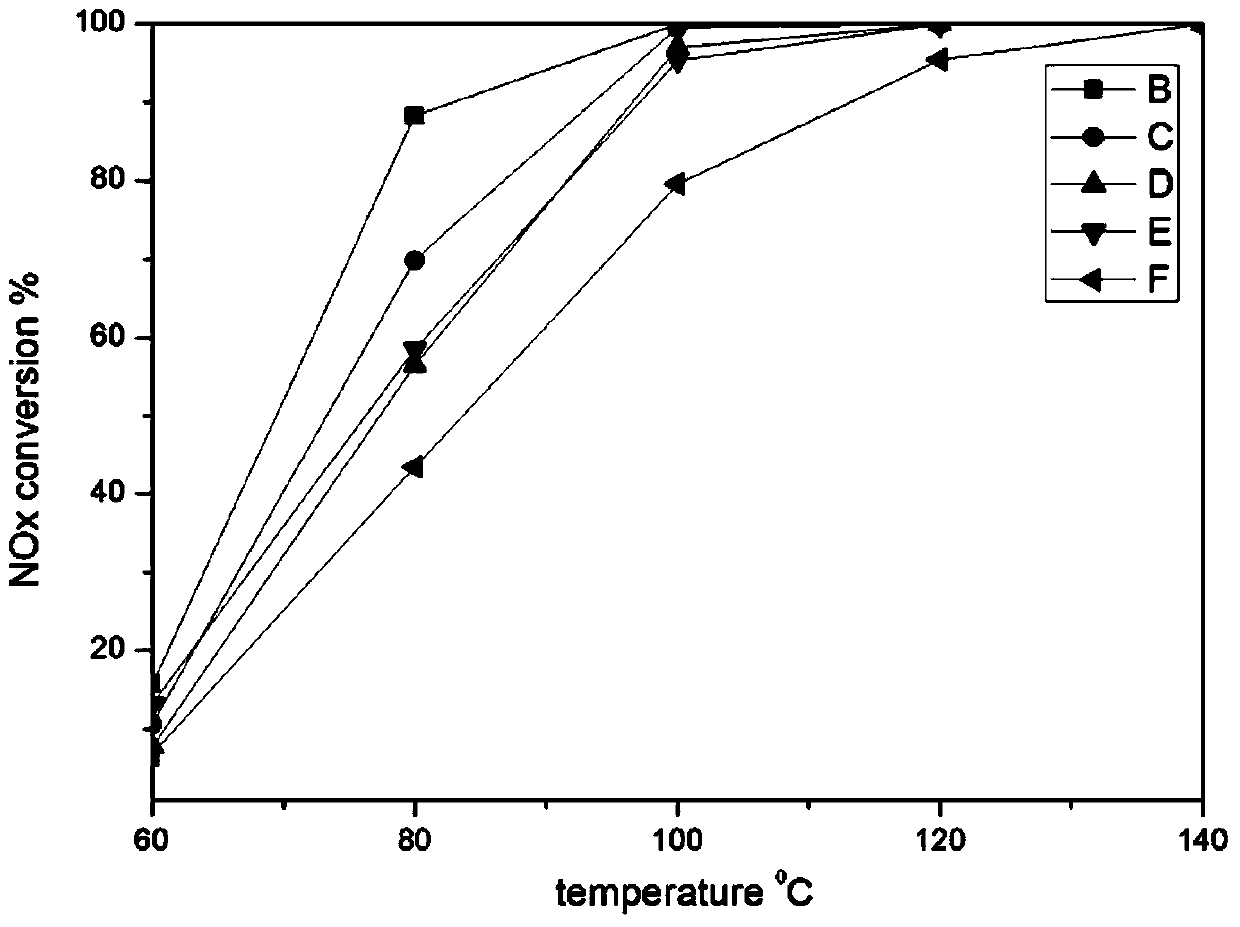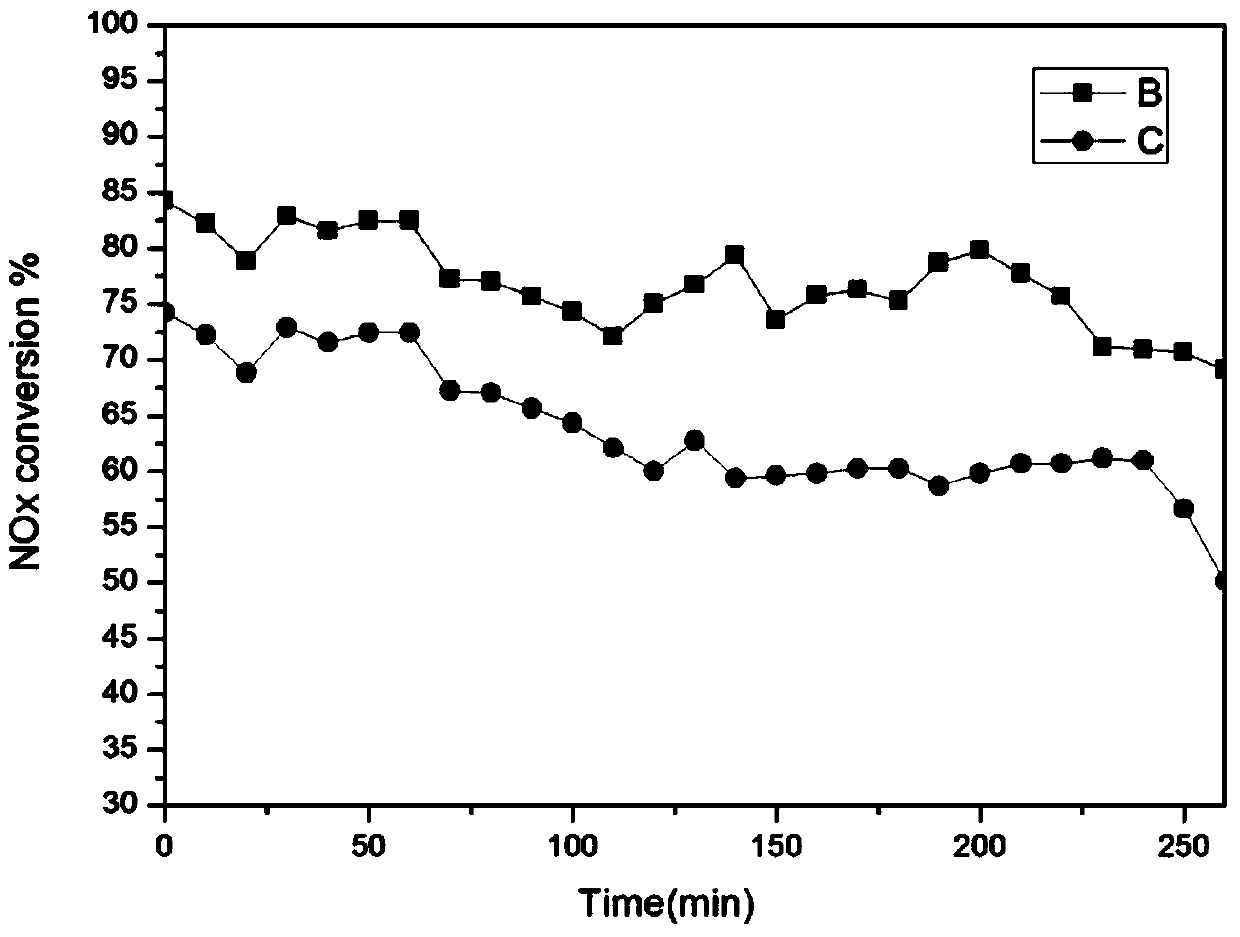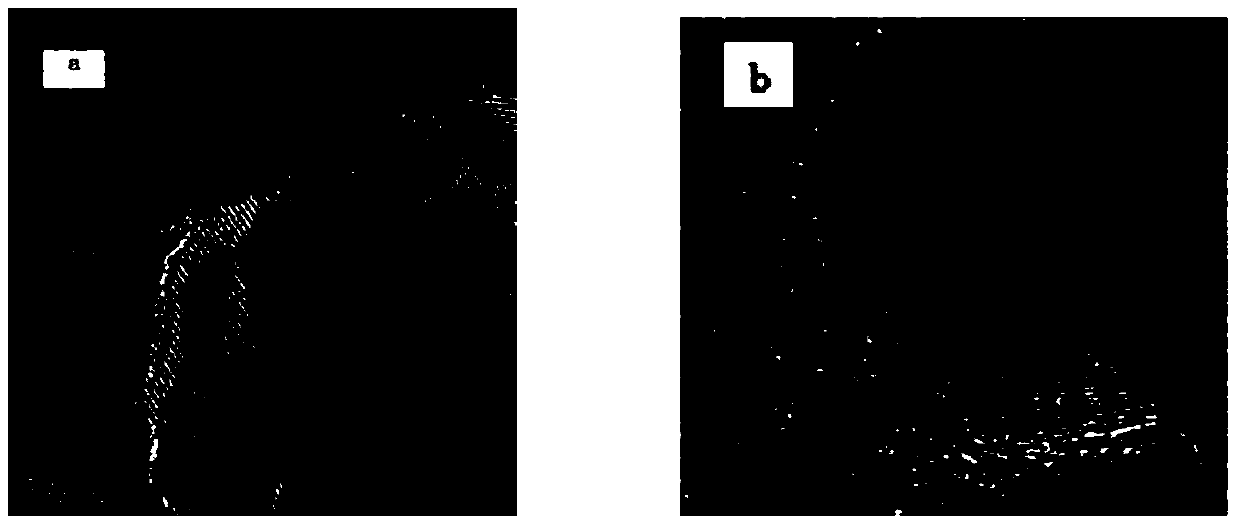Low-temperature SCR denitration catalyst with titanium-based core-shell structure and preparation method of catalyst
A denitration catalyst, core-shell structure technology, applied in chemical instruments and methods, physical/chemical process catalysts, metal/metal oxide/metal hydroxide catalysts, etc., can solve the problems such as manganese, cerium and titanium catalysts, poisoning, etc. , to achieve the effect of improving anti-SO2 ability, inhibiting erosion, good denitration activity and selectivity
- Summary
- Abstract
- Description
- Claims
- Application Information
AI Technical Summary
Problems solved by technology
Method used
Image
Examples
Embodiment 1
[0018] Using the hydrothermal method, select the molar ratio of Mn:Ce:Ti to be 0.4:0.07:1. Using cerium nitrate, manganese nitrate, water, and sodium hydroxide as raw materials, the cerium nitrate and manganese nitrate are respectively configured into an aqueous solution with a mass fraction of 20%, and a sodium hydroxide solution with a concentration of 6mol / L is added dropwise until the analysis is complete, and then Transfer the mixed solution to a hydrothermal kettle, react at 120°C for 24h, centrifuge, and alternately wash with deionized water and ethanol, dry the solid at 80°C for 24h, and finally calcinate at 550°C for 4h to obtain nano-MnOx-CeO 2 particulates. The core-shell nanoparticles were prepared in an inverse microemulsion with CTAB as surfactant, n-pentanol as co-surfactant, and cyclohexane as oil phase, wherein the mass fraction of CTAB was 10%, and the mass fraction of cyclohexane was The fraction is 40%, and the mass fraction of n-pentanol is 50%. First mi...
Embodiment 2
[0020] Using the hydrothermal method, the molar ratio of Mn:Ce:Ti is selected as 0.4:0.8:1. Using cerium nitrate, manganese nitrate, water, and sodium hydroxide as raw materials, the cerium nitrate and manganese nitrate are respectively configured into an aqueous solution with a mass fraction of 20%, and a sodium hydroxide solution with a concentration of 6mol / L is added dropwise until the analysis is complete, and then Transfer the mixed solution to a hydrothermal kettle, react at 120°C for 24h, centrifuge, and alternately wash with deionized water and ethanol, dry the solid at 80°C for 24h, and finally calcinate at 550°C for 4h to obtain nano-MnOx-CeO 2 particulates. The core-shell nanoparticles were prepared in the inverse microemulsion with CTAB as surfactant, n-pentanol as co-surfactant and cyclohexane as oil phase. First mix 6% CTAB, 30% cyclohexane and 64% n-pentanol, stir until transparent, then add MnOx-CeO 2 Nanoparticle dispersion. Adjust the pH value with nitric...
Embodiment 3
[0022]Using the hydrothermal method, select the molar ratio of Mn:Ce:Ti to be 0.3:1:1. Using cerium nitrate, manganese nitrate, water, and sodium hydroxide as raw materials, the cerium nitrate and manganese nitrate are respectively configured into an aqueous solution with a mass fraction of 20%, and a sodium hydroxide solution with a concentration of 6mol / L is added dropwise until the analysis is complete, and then Transfer the mixed solution to a hydrothermal kettle, react at 120°C for 24h, centrifuge, and alternately wash with deionized water and ethanol, dry the solid at 80°C for 24h, and finally calcinate at 550°C for 4h to obtain nano-MnOx-CeO 2 particulates. The core-shell nanoparticles were prepared in an inverse microemulsion with CTAB as surfactant, n-pentanol as co-surfactant, and cyclohexane as oil phase, wherein the mass fraction of CTAB was 8%, and the mass fraction of cyclohexane was The fraction is 30%, and the mass fraction of n-pentanol is 62%. First CTAB, c...
PUM
| Property | Measurement | Unit |
|---|---|---|
| size | aaaaa | aaaaa |
| particle diameter | aaaaa | aaaaa |
Abstract
Description
Claims
Application Information
 Login to View More
Login to View More - R&D
- Intellectual Property
- Life Sciences
- Materials
- Tech Scout
- Unparalleled Data Quality
- Higher Quality Content
- 60% Fewer Hallucinations
Browse by: Latest US Patents, China's latest patents, Technical Efficacy Thesaurus, Application Domain, Technology Topic, Popular Technical Reports.
© 2025 PatSnap. All rights reserved.Legal|Privacy policy|Modern Slavery Act Transparency Statement|Sitemap|About US| Contact US: help@patsnap.com



